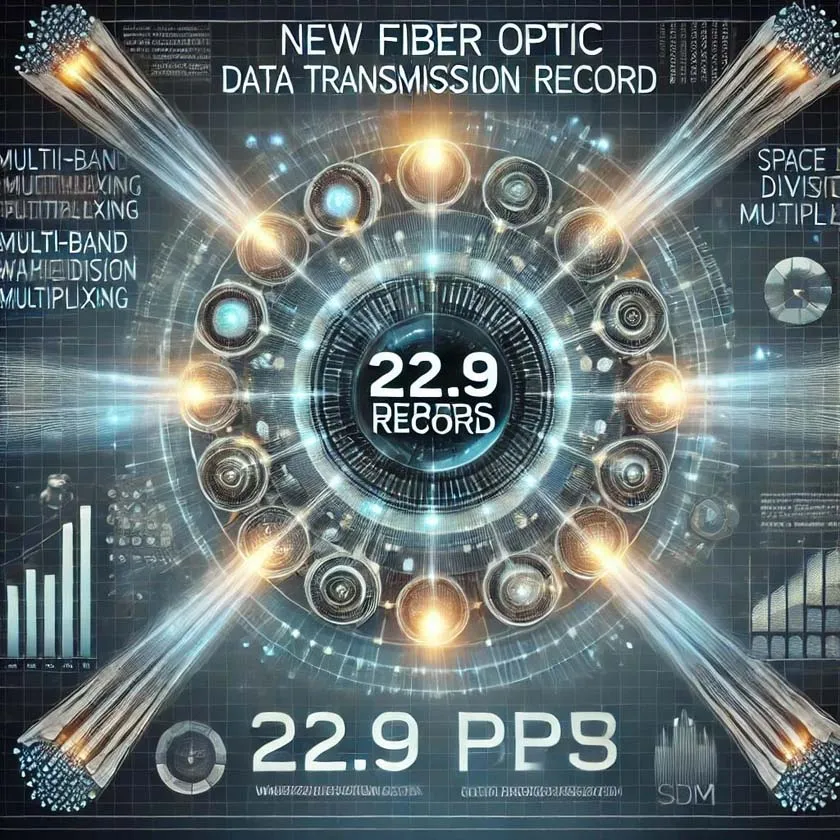In today’s data-driven society, the capacity for high-speed data transmission has become a critical foundation for the global digital economy. As cloud computing, 5G networks, and data centers rapidly expand, the demand for ultra-fast data transmission has never been more pressing. Fiber optic communication technology, particularly Wavelength Division Multiplexing (WDM), has emerged as a cornerstone in meeting this demand. Recently, Japan’s National Institute of Information and Communications Technology (NICT) set a new fiber optic data transmission record, achieving an unprecedented rate of 22.9 petabits per second (Pbps). This breakthrough is set to propel the development of global communication infrastructure to new heights.
1. Integration of Multi-Band WDM and SDM Technologies
In traditional fiber optic communication systems, the transmission capacity of a single wavelength is limited by the material properties of the fiber and the transmission distance, making it challenging to meet the growing demand for data. To overcome this bottleneck, the NICT research team integrated multi-band WDM and Space Division Multiplexing (SDM) technologies. WDM allows multiple wavelengths of light to be transmitted simultaneously over a single fiber, while SDM enhances fiber capacity by introducing multi-core, multi-mode structures within the same fiber.
In this recent experiment, researchers successfully combined multi-band WDM with multi-core, multi-mode SDM technology for the first time, achieving transmission capacities of 0.3 to 0.7 Pbps per core, leading to a total capacity of 22.9 Pbps. This speed is equivalent to 1,000 times the data rate of commercially deployed fiber optic communication systems today. To achieve this remarkable speed, the research team employed advanced Multiple Input Multiple Output (MIMO) receivers and forward error correction coding techniques to ensure reliable signal transmission and low error rates.
2. Future Prospects for Fiber Optic Communication Systems
This new record represents not only a significant breakthrough in fiber optic communication technology but also lays the groundwork for future ultra-high-capacity communication networks. In the coming years, as data-intensive applications such as 8K video streaming, virtual reality, artificial intelligence training, and the massive data transfer required by IoT devices become more prevalent, the current communication infrastructure may face severe bottlenecks. With global data traffic expected to increase by orders of magnitude in the coming years, current systems may struggle to handle such enormous demands.
The NICT study demonstrates that by combining multi-band WDM and SDM technologies, ultra-high-capacity fiber transmission is achievable. This technology will play a key role in future communication networks, especially in building efficient data center interconnects, 5G infrastructure, and global internet backbones. As data traffic continues to surge, further development and commercialization of these technologies will be essential tasks for the telecommunications industry.
3. The Driving Force of Continuous Innovation
To bring these technologies to widespread use, several challenges must still be overcome. For example, the manufacture of high-precision multi-mode multi-core fibers and corresponding high-bandwidth receivers remains a critical issue. Additionally, ensuring signal stability and low energy consumption in long-distance transmissions will be crucial for future research.
NICT’s research once again highlights the importance of continuous innovation in driving the development of communication technologies. As technology continues to advance, the potential of fiber optic communications will be further unlocked, ushering in a new era for global information infrastructure.
Amid the rapid development of global fiber optic communication technology, HTF (HengTong Fiber) has emerged as an industry leader, known for its excellence in technological innovation and extensive market reach. HTF is dedicated to helping customers build, connect, and optimize fiber optic infrastructure, providing comprehensive transmission solutions particularly in the fields of data centers, 5G networks, cloud computing, metropolitan area networks, and access networks.
HTF’s technological prowess has been recognized globally, with over 200 corporate awards and titles, more than 120 proprietary intellectual properties, and over 160 invention patents. The company’s operations span numerous countries and regions worldwide, consistently delivering high-quality products and support services. Through relentless innovation and market expansion, HTF has established itself as an indispensable force in the global fiber optic communication industry, driving the sector forward.






